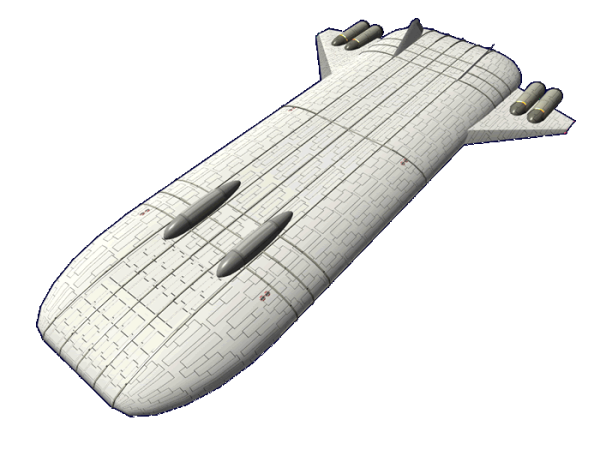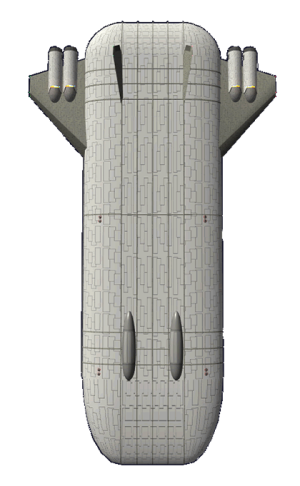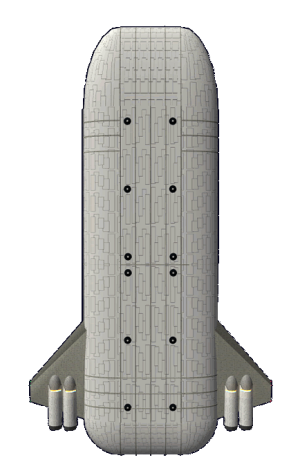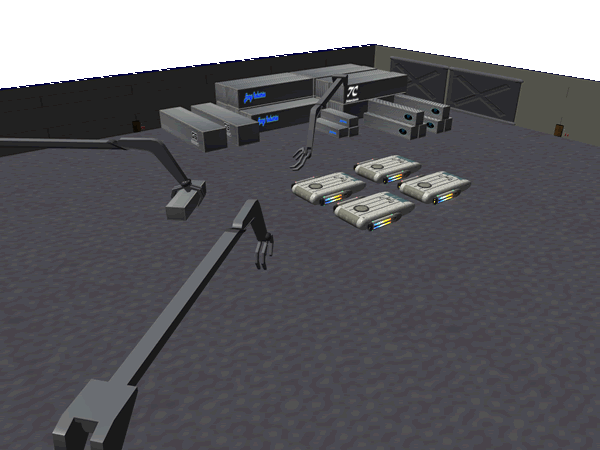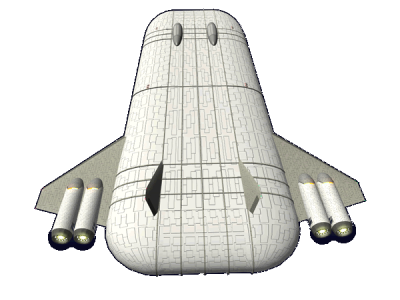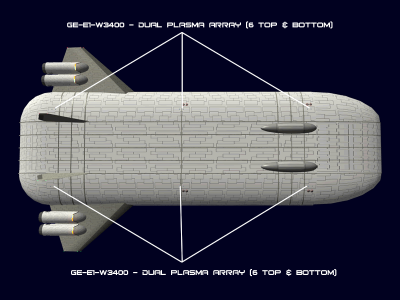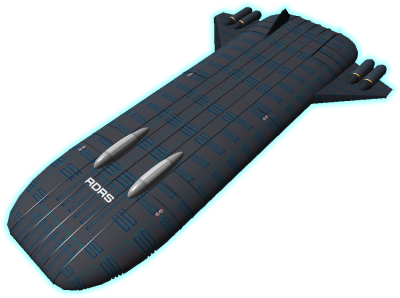Sidebar
Table of Contents
Ge-L6-1a - Taishita-Class (Heavy Freighter)
The Ge-L6 is a heavy size freighter, designed to carry as much cargo as possible with some consideration for passengers. It became available in YE 34. The version of this ship re-designed for disaster recovery operations is the RDRS Ge-L6-2a - Jihi Class Freighter.
About the Taishita
History
During the months after Battle of Yamatai, the corporation saw that there was a need for larger freighters than they currently offered. The Taishita-Class design is larger than any other currently available design in the Empire. The initial plan for the large freighters was to help with the massive food shipment effort.
Appearance
The Taishita-Class shape is that of a rounded rectangle with a tapered bow. It has two wings to which the four turbo-plasma drives are attached. The wings and the two vertical stabilizers help with the ship's performance in the atmosphere. On the top of the hull are two rounded protrusions which is where the ship's small craft for cargo transfer are housed. Additionally on the top the eight escape pod launch points can be seen by their covers. On the bottom of the ship the twelve graviton engines used for lift off and landing and low level atmospheric travel can be seen.
Specifications
General
Class: Taishita-class Nomenclature: Ge-L6-1a Type: Freighter, Heavy Designers: Tamahagane Corporation R&D Manufacturer: Geshrinari Shipyards Price: 300,000 KS (Without customization)
Crew and Accommodations
Crew: 100 Passengers: 30 Maximum Capacity: There are accommodations for 260 personnel with double occupancy. Emergency Capacity: 500 people can fit aboard in an emergency, but the ship would be extremely cramped.
Speeds
The Taishita is not built for agility.
- Atmospheric: 2,4250 km/h, or 1,522.4 mph (Mach 2)
-
- Minimum: Resting motionless
- Sublight: .3c (~89,937 kilometers per second) (~55,884 miles per second)
- Maximum Speed: 18,750c (~2.14 ly/h)
- Hyperspace Drive: 394,470c (0.75 ly/m)
Durability and Maintenance
Service Lifespan: Estimated 20 years of constant use, possibly longer with refits.
Refit Cycle: Frequent minor updates through refits once every four to five years.
Damage Capacity
See Damage Rating (Version 3) for an explanation of the damage system.
- Hull: 32
- Shields: 40 (Threshold 4)
Dimensions
Length: 590 meters (1936 feet) Width: 195 meters (640 feet) Height: 60 meters (197 feet) Decks: 10 (4 meters each)
Inside the Taishita-Class
This table gives the designation of each deck; beneath it is the description and purpose of each deck.
| Deck | Name |
|---|---|
| Zero | Over Deck |
| One | Crew Deck |
| Two | Flight Deck |
| Three | Hold Deck A/1 |
| Four | Hold Deck A/2 |
| Five | Hold Deck A/3 |
| Six | Hold Deck A/4 |
| Seven | Hold Deck B/1 |
| Eight | Hold Deck B/2 |
| Nine | Hold Deck B/3 |
| Ten | Support Deck |
Crew Deck
Located at the top of the ship, Crew Deck is dedicated to the care and well being of the crew. It houses the crew quarters, the common baths and toilets. Located in the stern are the laundry rooms. Located in the center of the deck is the fitness area and lounge.
The deck has three corridor that run the length of the ship, the center one is referred to as Mainway, the other two are referred to as Portway and Starboardway. These hallways exist on both decks one and two. Stairwells and lifts allow movement vertically between deck one and two. There are also four passages that run from port to starboard, at each juncture there is a Damage Control Station. Located on this deck are the escape pod stations.
Flight Deck
The second deck is referred to as the flight deck. It is where the command operations of the ship are located. In the forward part of this deck, the passenger quarters are located. The Dining Room, Galley with Scullery and Passenger Lounge, common restrooms are next on the deck.
The bridge, computer room, medical bay, Crew Lounge, common restrooms.
The deck has three corridor that run the length of the ship, the center one is referred to as Mainway, the other two are referred to as Portway and Starboardway. These hallways exist on both decks one and two. There are also four passages that run from port to starboard.
Hold Deck A/1
This is dominated by Hold A, located in the front of the ship is the sensor array. The sides of the deck have walkways that go around the cargo elevator shafts. The forward section is the upper portion of the large shuttle bay. The aft section of the deck is the upper portion of the Geshrinari Life Support Room.
Hold Deck A/2
This is dominated by Hold A, located in the front of the ship is the sensor array. The sides of the deck have walkways that go around the cargo elevator shafts. The forward section is the lower portion of the large shuttle bay. The aft section of the deck is the lower portion of the Geshrinari Life Support Room.
Hold Deck A/3
This is dominated by Hold A, located in the front of the ship is the sensor array. The sides of the deck have walkways that go around the cargo elevator shafts. The aft section of the deck is the upper portion of the Engineering.
Hold Deck A/4
This is dominated by top of Hold B, located in the front of the ship is the sensor array. The sides of the deck have walkways that go around the cargo elevator shafts. The aft section of the deck is the lower portion of the Engineering.
Hold Deck B/1
This is dominated by the upper portion of Hold B, located in the front of the ship is EVA area. It is fitted with two large airlocks. A small Armory is located next to the Ship's locker. The sides of the deck have walkways that go around the cargo elevator shafts. The cargo bay doors are lined up with the elevator shafts. The aft section of the deck is the storage space for use by the crew separate from the cargo hold. This is where provision and other consumables are kept.
Hold Deck B/2
This is dominated by middle of Hold B, located in the front of the ship is the Geshrinari Fabrication Area. The sides of the deck have walkways that go around the cargo elevator shafts. The cargo bay doors are lined up with the elevator shafts. The aft section of the deck is the lower portion of the Vehicle Bay.
Hold Deck B/3
This is dominated by bottom of Hold B, located in the front of the ship is the Geshrinari Fabrication Area. The sides of the deck have walkways that go around the cargo elevator shafts. The cargo bay doors are lined up with the elevator shafts. The aft section of the deck is the lower portion of the Vehicle Bay.
Support Deck
Located at the bottom of the ship, the Support Deck houses the Taishita's landing gear, the Graviton Engines, and the equipment for operating the twelve cargo elevators. Also this is where the water tanks are for the environmental system, and the emergency reserves of atmosphere gases.
Over Deck
Located above deck one is the over deck. It houses the two Utility craft berths, referred to as Spider Nests.
Compartments
Bridge
Computer
Crew Related
Baths
Engineering
Emergency
Medical
Social
Utility
Utility Craft Berths
These tear drop shaped chambers are located on the top of the Taishita. These chambers feature clam-shell doors on the top that open to allow the utility craft to exit and enter. The berth is twenty meters wide at the widest, ten meters high at the apex, and sixty meters long.
Each berth is capable of holding 36 Ge-T4-1a - Kumo-Class CTU. This gives the Taishita a total capacity of 72.
During launch and recovery once the clam-shells are opened, an atmospheric shield is maintained to allow personnel to enter and exit the Ge-T4-1a - Kumo-Class CTU. Because of the craft are Kumo or Spider, the berths are also referred to as Spider Nests.
Storage
- Armory maybe
Cargo Holds
The heart of the Taishita-Class is the two large isolated cargo bays. Around them is crew space, and there are an array of cargo elevators for raising and lowering Standard Starship Cargo Containers. Each hold is divided into three sections of 110 meters, and each has four elevators. Isolation force fields are placed at the dividing points in the event of hull breach. There are tie-down points on the floor to secure odd shaped cargo, and there are robotic arms and cranes that move the containers into position.
The elevators are 21 meters long, 10 meters deep, and 4.5 meters high. For cargo being loaded into hold B the cargo rolls through the elevator. The elevators are for mainly raising the cargo to Hold A.
Hold A
Dimensions:
- 16 meters high
- 140 meters wide
- 330 meters long
SSCC Capacity:
- Huge: 1,664
- XL: 5,913
- Large: 13,306
- Medium: 26,612
Hold B
Dimensions:
- 12 meters high
- 140 meters wide
- 330 meters long
SSCC Capacity:
- Huge: 1,248
- XL: 4,436
- Large: 9,980
- Medium: 19,959
Escape Pod Stations
The Taishita features a unique feature. Instead of having Ge-X3300 - Type 33 Escape Pod scatter all over the ship, they have four stations where customers get aboard escape pods. Once a pod is full it is launched, and another pod rises into position and the exterior door opens. Each shaft can hold up to eight pods and there are two shafts per station. This gives the ship a maximum capacity of 384 persons in the escape pods.
However, under normal circumstances the Taishita typically only carries 26 pods.
Support Deck
This is the bottom of the ship, it houses the Taishita's landing gear, the Geshrinari Graviton Engine, and the equipment for operating the twelve cargo elevators.
Systems
Computer
The Tashita 1a uses a Ge-Y2-E3300 - Hogosha Quantum Computer System for all its computation needs.
The Tashita 1b uses a MEGAMI for all its computation needs.
Communications
Communications on the Taishita uses the Ge-Y1-E3103 - Intercom System for internal, and Ge-Y2-E3302 - Communications Suite for external.
Life Support
The life support requirements for the Taishita are supplied by a pair Ge-Y1-V3100 - Life Support System.
Emergency Systems
The Taishita features the following emergency systems.
Security
The Taishita has the following standard security features.
Sensors
The Taishita uses the Ge-Y2-E3301 - Standard Starship Sensors for its sensor requirements.
Weaponry
The weapon systems of the Taishita are controlled by a Ge-Y2-E3306 - Fire Control System. They protect the ship from those who would attempt to prey upon it. They are arranged in pairs in twelve locations.
- 24 Ge-E1-W3400 - Dual Plasma Array Single: 3 ADR / Paired 1 SDR / 5 ADR
While not a true weapon the Taishita is equipped with a pair of Geshrinari Graviton Beam Projectors, they are each mounted amidships on the side.
Propulsion
The Taishita has a variety of engines to help it operate safely.
It uses 12 Geshrinari Graviton Engine which are used for landing and lift off and lower level atmospheric travel.
It has clusters of Geshrinari Maneuvering Thrusters located along the hull on the ship's axises. These are used for docking maneuvers and station keeping.
It is equipped with four Geshrinari Turbo Plasma Drive mounted on the atmospheric wings, they are for in system travel.
It is equipped with a Geshrinari Continuum Distortion Drive and a Geshrinari Hyperspace Fold Drive for FTL travel. Typically the fold is used for long distance travel, and the CDD is for shorter distances.
Power
The Taishita equipped with two power systems. Primary power is supplied by a Geshrinari Aether Generator. In the event of a failure or the ship is on the ground without external power, the uses a Geshrinari Anti-Matter Generator. The Taishita is equipped with Geshrinari Matter Collection System to refuel.
CFS
For defense the Taishita is outfitted with a Geshrinari Combined Field System for its shielding.
Armored Hulls
Because of the size of the Taishita the company chose to use their strongest structure for the hull GE-V1-H3302 - Spacecraft (OO) Hull Construction.
Landing Gear
The Taishita was designed for planetary landing, so it is equipped with sixteen pneumatically driven landing gears. Each landing gear is independently controlled, and working in concert they can level the ship to compensate for uneven terrain.
Vehicles
Disaster Recovery Version
The redesigned Disaster Recovery version of this ship is the RDRS Ge-L6-2a - Jihi Class Freighter, pictured below.
OOC Notes
Authored by Nashoba Apr 10, 2012 Artwork created by Nashoba Submission Approved by Wes on Apr 11, 2012. Forum Thread.
| Products & Items Database | |
|---|---|
| Product Categories | starships |
| Product Name | Taishita-Class Heavy Freighter |
| Nomenclature | Ge-L6-1A |
| Manufacturer | Geshrinari Shipyards |
| Year Released | YE 34 |
| Price (KS) | 300 ,000.00 KS |
Page Tools
Terms of Service - Privacy Policy



